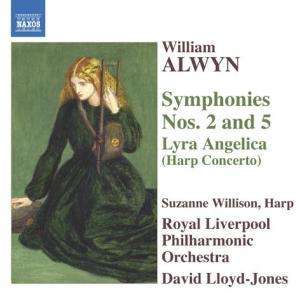William Alwyn: Symphonien Nr.2 & 5 on CD
Symphonien Nr.2 & 5
Conventional CD, playable with all CD players and computer drives, but also with most SACD or multiplayers.
Let our eCourier notify you if the product can be ordered.
+Harfenkonzert "Lyra Angelica"
- Artists:
- Suzanne Willison, Royal Liverpool Philharmonic Orchestra, David Lloyd-Jones
- Label:
- Naxos
- Year of recording ca.:
- 2005
- UPC/EAN:
- 0747313264728
- Release date:
- 11.7.2005
Similar Articles
Sinfonie Nr. 2, die zweite meines Zyklus von vier Sinfonien, stand in völligem Gegensatz zu Nr. 1. Alle Überbleibsel der klassischen Form wurden aufgegeben. Ich konzipierte sie in einem durchgehenden Satz, nur unterbrochen durch eine kurze Pause vor Teil II, wo die Musik in ein turbulentes Allegro eintaucht, im Gegensatz zu dem leise ekstatischen Abschnitt, der ihr vorausging. Die Symphonie konzentriert sich auf die Entwicklung eines einzigen Hauptmotivs, begleitet von ominösen Trioleneinwürfen auf den Pauken, die zu einem gewaltigen Höhepunkt führen, der schließlich in eine ruhige, fast modale Pianissimo-Coda mündet. Ich wünschte, ich könnte sagen, dass das (1953 uraufgeführte) Werk ein sofortiger Erfolg war, aber obwohl es vom Publikum herzlich aufgenommen wurde, stieß es auf erheblichen Widerstand bei den Kritikern, die angesichts meiner symphonischen Neuerungen außer sich waren und weder meine harmonische Offenheit (unerschütterliches Festhalten an den Grundzügen von Tonalität und Melodie) noch die neue Freiheit meiner formalen Gestaltung verstanden ... [die Zweite Symphonie] ist mein Favorit unter den fünf Sinfonien.
Die Symphonie Nr. 5 wurde vom Arts Council für das 1973 in Norfolk und Norwich stattfindende Triennale Festival in Auftrag gegeben. Seit der Komposition meiner vierten Sinfonie waren vierzehn Jahre vergangen; eine Zeit, die fast vollständig mit der Komposition meiner beiden Opern Juan oder Libertine und Fräulein Julie verbracht wurde. Während dieser Zeit hatte sich meine Einstellung zum symphonischen Schreiben radikal verändert. Mein Ziel war es nun, die übermäßige Länge der spätromantischen viersätzigen Symphonie in ein kurzes einsätziges Werk zu komprimieren und dabei die dramatischen Kontraste der traditionellen symphonischen Form beizubehalten, sie aber auf vier kurze Abschnitte zu beschränken.
Product Information
Symphony No. 2, the second of my cycle of four symphonies, was in complete contrast to No. 1. All vestige of classical form was abandoned. I conceived it in one continuous movement only broken by a momentary pause before Part II where the music plunges into a tumultuous Allegro in contrast to the quietly ecstatic section that preceded it. The symphony concentrates on the development of a single main motif, accompanied by ominous triplet interjections on the timpani, building to a huge climax which finally resolves into a tranquil, almost modal pianissimo coda. I wish I could say that the work (first performed in 1953) was an immediate success but, although warmly received by the audience, it met with considerable opposition from the critics who were all at sea when faced by my symphonic innovations, neither understanding my harmonic frankness (steadfast adherence to the basic essentials of tonality and melody) or the new freedom of my formal design ... [the Second Symphony] is my favourite of the five.
Symphony No. 5 was commissioned by the Arts Council for the 1973 Norfolk and Norwich Triennial Festival. A gap of fourteen years had elapsed since the composition of my fourth symphony; a period almost totally occupied in the composition of my two operas, Juan, or the Libertine and Miss Julie. During that time my attitude to symphonic writing had radically changed. My aim now was to compress the inordinate length of the late-romantic four-movement symphony into a short one-movement work while still preserving the dramatic contrasts of the traditional symphonic form but confining it to four brief sections.
Disk 1 von 1 (CD)
-
1 Symphony No. 5, "Hydriotaphia"
-
2 Harp Concerto, "Lyra Angelica" : I. Adagio
-
3 Harp Concerto, "Lyra Angelica" : II. Adagio, ma non troppo
-
4 Harp Concerto, "lyra Angelica" : Iii. Moderato
-
5 Harp Concerto, "Lyra Angelica" : IV. Allegro giubiloso - Andante con moto
-
6 Symphony No. 2 : I. Con moto - Molto moderato - Quasi Adagio molto calmato
-
7 Symphony No. 2 : II. Allegro molto - Moderato largamente - Molto










